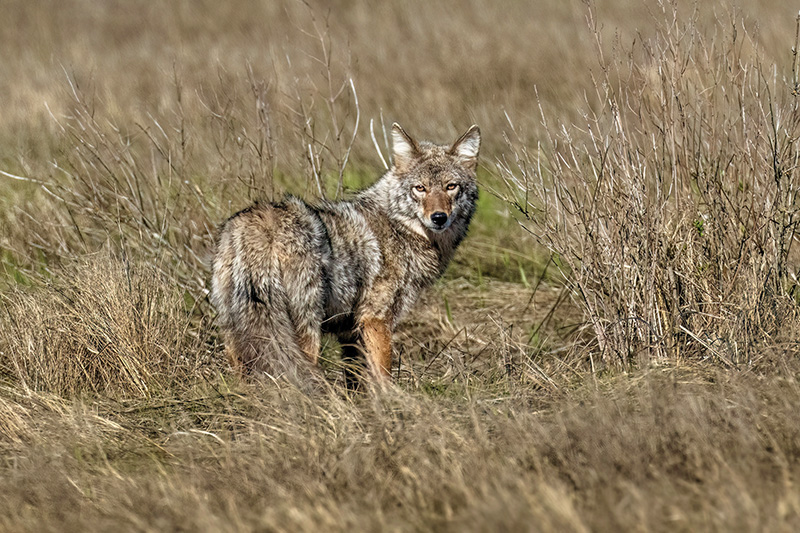 This article appears in the Summer 2024 issue
This article appears in the Summer 2024 issue

Are Coyotes Living Near You?

Image credit: Ingrid Feddersen.
Hiking last summer in Barn Island Wildlife Management Area, a beautiful 1,000-acre preserve in the southeast corner of Connecticut, my eyes spotted movement about fifty feet off to my right in the shadows of the forest. As I turned my head to see what it was, I thought I saw a dog—a stray—duck behind a tree.
Wait, I told myself. This one had pointy ears, a narrow snout, and looked more wolf-like than anything else.
Was it a coyote? Possibly. But I will never know, because within the next few seconds, this secretive, incredibly quiet animal seemed to vanish before my eyes. Mind you, this is an animal—if it was a coyote—that’s big. Coyotes weigh thirty to forty-five pounds (males are typically heavier) and measure forty-eight to sixty inches long from nose to tail, and they’re fast. They can run thirty-five to forty-five miles per hour.
I remembered how the Connecticut Department of Energy and Environmental Protection (CT DEEP) described Eastern coyotes, the ones that roughly live east of the Mississippi River: “They resemble a small, lanky German Shepherd dog, but have wide pointed ears, a long muzzle, yellow eyes, and an uncurled tail, which is carried low to the ground.” They also said a coyote’s scientific name is Canis latrans, which means “barking dog.”
Unfortunately, the shadows in the forest prevented me from verifying many of these coyote trademarks, but, nonetheless, I was quite sure I had a close encounter with a coyote, and the experience left me gripping my stout maple walking stick more securely, as I continued through the forest.
How Coyotes Populated New England
Most people have never seen a coyote, nor would care to. But nowadays, these amazing animals—who are either loved or hated—are ubiquitous, living near us in every state except Hawaii. The story of how coyotes populated New England is an interesting one.
Sometime around the 1930s, according to Chris Vann, nuisance wildlife biologist for CT DEEP, coyote populations began expanding from their base in the plains states into the Great Lakes region of Canada, moving across the northern midwestern states, and eastward into New England. The extirpation of the gray wolf in those areas left a void which the coyotes soon filled, Vann said.
Today there are an estimated 3,000 to 5,000 coyotes in Connecticut, 3,600 in Rhode Island, 12,000 in Massachusetts, 4,500 in New Hampshire, 3,000 to 5,000 in Vermont, and another 10,000 to 12,000 in Maine. Their populations are stable, according to experts, despite hunting and trapping efforts in many states.
Their Genetics Are a Bit “Wonky”
Bree Furvey, furbearer project leader for the Vermont Fish and Wildlife Department, helped me understand why some Eastern coyotes look more wolf-like than others. Here’s a sampling of our discussion:
“What’s unique about Eastern coyotes?” I asked.
“Two things,” Furvey said. “One is how well they’ve adapted to humans and human development. They can be found in any environment. And they don’t seem to be suffering the consequences, like other species are, from human development and loss of habitat.”
“The other thing that’s unique about Eastern coyotes,” Furvey continued, “is the fact that their genetics is a little bit wonky.”
“What do you mean by that?” I interjected.
“Their migration over here is well agreed upon in the scientific community. Some went across the US, underneath Canada, others took the route through Canada, Ontario, and Quebec, then down into New England.”
“In that process,” Furvey explained, “the coyotes mixed with the Great Lakes wolf, which is the gray wolf that you see out West. They also mixed with the Eastern wolf from Algonquin Provincial Park [a vast 2,946-square-mile chunk of wilderness in south-central Ontario] and mixed a little bit with domestic dogs, before coming into New England.”
This interbreeding between coyotes, wolves, and domestic dogs “is super interesting to me,” Furvey said. “You look at a coyote and say that it could be one hundred percent coyote, or it could have some wolf genetics, or domestic dog in it.”
Finally, I asked Furvey why coyotes are important to the ecosystem. Her answer was eloquent.
“As a predator, they provide food chain balance. That is, they help control normal mortality for a lot of different species. For example, I’m thinking about the [Vermont] hare, so that that population doesn’t become overgrown. They also serve as disbursers of plants, seeds, and berries that they eat.”
Each year, Furvey and her colleagues record short educational videos for kids about coyotes and different species, filled with fun facts. Then they visit fifty different schools in the state, sit with the kids, show them the videos, and have a Q&A.
“Is that fun for you?” I asked. Her smile was audible.
“Being a champion for a species like coyotes is my job,” Furvey admitted. “But it’s more than a job. It’s my passion. I’m going to be the person out there that’s speaking very highly of these species because they deserve to be spoken very highly about.”
We should all be thankful we have dedicated people like Furvey, working in our Fish and Game Departments.
Bill Hobbs is a contributing nature writer and columnist for Estuary magazine. He lives in Stonington, Connecticut, and can be reached for comments at whobbs246@gmail.com.
